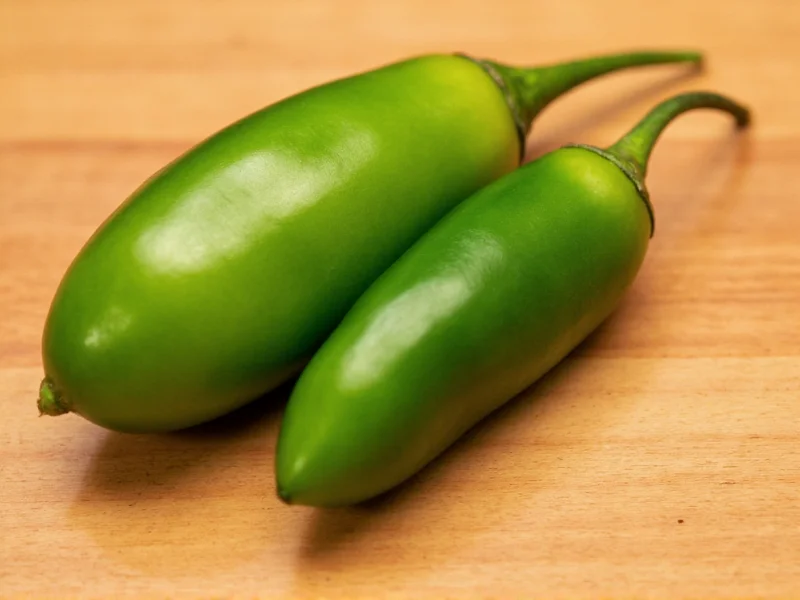Understanding where jalapeños fall on the Scoville scale helps home cooks and spice enthusiasts gauge their heat level before adding them to recipes. The Scoville scale, developed by pharmacist Wilbur Scoville in 1912, measures the concentration of capsaicin—the compound responsible for a pepper's heat—in Scoville Heat Units (SHU).
Why Jalapeños Have a Heat Range Instead of a Single Value
Jalapeños don't have a fixed Scoville rating because multiple factors influence their capsaicin content:
- Maturity: Riper red jalapeños typically measure hotter than green ones
- Stress factors: Drought or nutrient deficiency can increase heat levels
- Genetic variation: Different cultivars produce varying heat intensities
- Part of the pepper: Seeds and inner membranes contain the highest capsaicin concentration
- Geographic origin: Growing region affects final heat measurement
Jalapeño Heat Compared to Other Common Peppers
| Pepper Type | Scoville Heat Units (SHU) | Relative Heat Level |
|---|---|---|
| Bell Pepper | 0 SHU | Mild |
| Jalapeño | 2,500-8,000 SHU | Medium |
| Serrano | 10,000-23,000 SHU | Hot |
| Habanero | 100,000-350,000 SHU | Very Hot |
| Ghost Pepper | 855,000-1,041,427 SHU | Extreme |
Practical Implications for Cooks and Consumers
Knowing jalapeños' position on the Scoville scale helps manage heat in cooking. At 2,500-8,000 SHU, they're significantly milder than habaneros but noticeably hotter than poblano peppers (1,000-2,000 SHU). This medium heat level makes jalapeños versatile for salsas, nachos, and stuffed pepper recipes without overwhelming other flavors.
When handling jalapeños, remember that capsaicin transfers easily to skin and eyes. Always wear gloves when cutting hot peppers and wash hands thoroughly afterward. Removing seeds and white membranes reduces heat intensity by up to 80%, as these parts contain the highest capsaicin concentration.
Popular Jalapeño Varieties and Their Heat Levels
Different jalapeño cultivars exhibit varying heat intensities within the standard range:
- Standard Jalapeño: 2,500-8,000 SHU (most common grocery store variety)
- Mucho Nacho Jalapeño: 4,500-6,000 SHU (bred for consistent heat in commercial growing)
- TAM Mild Jalapeño: 1,500-3,000 SHU (specifically developed for lower heat)
- Early Jalapeño: 3,000-5,000 SHU (known for early harvest and reliable production)
Measuring Pepper Heat: From Human Testing to Modern Methods
The original Scoville Organoleptic Test involved diluting pepper extract until human testers could no longer detect heat. Today, high-performance liquid chromatography (HPLC) provides precise capsaicin measurements, which are then converted to Scoville units. This modern approach explains why contemporary jalapeño measurements show more consistent ranges than historical data.
How to Select Jalapeños Based on Desired Heat Level
When shopping for jalapeños with specific heat characteristics, look for these visual indicators:
- More heat: Choose peppers with visible striations (white lines) and a slightly wrinkled appearance
- Milder heat: Select smooth, uniformly green peppers without stress markings
- Ripeness indicator: Red jalapeños have matured longer and typically measure hotter than green ones
Store jalapeños in the refrigerator's crisper drawer for up to two weeks. For longer storage, freeze whole peppers or slice and freeze in oil for cooking applications.
FAQ: Frequently Asked Questions About Jalapeños on the Scoville Scale
Why do some jalapeños taste hotter than others?
Jalapeño heat varies due to growing conditions, maturity level, and genetics. Stress factors like drought increase capsaicin production, while riper red jalapeños typically measure hotter than green ones. The seeds and inner membranes contain the highest concentration of capsaicin, so peppers with more developed placental tissue will taste hotter.
How does the jalapeño scoville range compare to other common peppers?
Jalapeños (2,500-8,000 SHU) are significantly hotter than poblanos (1,000-2,000 SHU) but milder than serranos (10,000-23,000 SHU). They measure about 14-45 times milder than habaneros (100,000-350,000 SHU). This medium heat level makes jalapeños versatile for cooking without overwhelming other flavors in dishes.
Can I reduce the heat of a jalapeño before using it in cooking?
Yes, removing the seeds and white membranes (placenta) can reduce heat by up to 80% since these parts contain the highest capsaicin concentration. Soaking sliced jalapeños in salt water or milk for 15-30 minutes can also draw out some capsaicin. For significantly milder results, choose smooth green jalapeños without visible striations, which typically indicate lower heat levels.
Are red jalapeños hotter than green jalapeños on the scoville scale?
Generally yes. Red jalapeños have remained on the plant longer to reach full ripeness, which typically increases capsaicin production. While both colors fall within the standard 2,500-8,000 SHU range, red jalapeños often measure toward the higher end of this spectrum. The extended growing period allows for more capsaicin development, though growing conditions remain the primary factor in final heat measurement.
What's the difference between Scoville units and actual perceived heat?
Scoville units measure capsaicin concentration objectively, but perceived heat varies between individuals due to differences in pain tolerance and previous exposure to spicy foods. Factors like the food matrix (what the pepper is cooked with), temperature, and even emotional state can affect how heat is perceived. Two peppers with identical Scoville measurements might taste differently hot to the same person depending on these variables.











 浙公网安备
33010002000092号
浙公网安备
33010002000092号 浙B2-20120091-4
浙B2-20120091-4